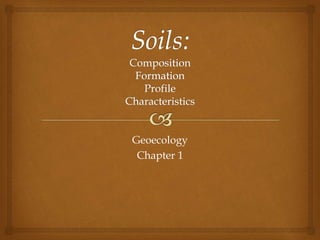
Soils
- 2. Soil Composition What is soil made up of?
- 4. Soil Composition 1. Mineral Matter: Rock particles from the bedrock and weathered rock. 2. Air: found in the pore spaces between rock grains. 3. Water: Also found in pore spaces. 4. Organic Material: Humus – a black sticky gel produced from decaying leaves and animals. Living organisms – earthworms, beetles, fungi, bacteria.
- 5. How are Soils Formed? 1. Solid rock particles break down from mechanical weathering. 2. Chemical weathering releases important nutrients from the rock grains. 4. Micro-organisms decompose the remains of plants to form humus which further enriches the soil. 3. Seeds are blown or carried onto the soil grains and may grow into plants that enrich the soil when they die. 5. The cycle continues until soils reaches maximum fertility given the climate it is in.
- 7. Soil Profiles Show the type of soil in the region. Defined as a vertical section of soil from the ground surface downwards to where soil meets the underlying rock. Composed of a number of distinctive layers called horizons. The key to understanding the processes involved in soil development.
- 8. Soil Profiles O = Organic horizon This has a high percentage of organic matter – leaves, plants and dead animals. Humus is formed as the dead organic matter decays. Also called the litter layer.
- 9. A Horizon Soil Profiles Known as topsoil. A dark organic material mixed with mineral soil grains. It is a source of plant nutrients and contains the majority of plant roots.
- 10. B Horizon Soil Profiles Also called the subsoil. The B horizon is the most widely used to identify soil type. May result purely from the weathering of underlying rock or from movement downwards of materials from horizons above.
- 11. C Horizon Soil Profiles Lies just above the bedrock. The overlying soil horizons often develop from the C horizon.
- 12. Soil Characteristics The characteristics of a soil influence the soil’s fertility. Characteristics: 1. 2. 3. 4. 5. 6. Colour Soil Structure Texture Organic Content PH Value Water Content
- 13. Soil Characteristics 1. Colour The colour of a soil indicates the amount of organic material in it. Humus-rich soils = black / dark drown. Leached soils = white. Dark soils absorb more sunlight and warm up more quickly, which aids seed germination. Pale coloured soils reflect sunlight and are slower to warm up.
- 14. Soil Characteristics: 2. Soil Structure soil grains or particles. This refers to the shape of the Soil grains or particles cluster together to form small lumps called peds. The shape of these peds indicates the structure of the soil. Common soils structures: 1. Crumb/ granular 2. Blocky 3. Platy
- 15. Crumb / Granular Loam soils have this structure. The peds are small rounded clumps of soil particles similar to breadcrumbs in size. This structure is good for holding air and water.
- 16. Blocky Sandy soils have this structure. Peds are closely packed angular blocks. Well drained but can be compacted easily - plants have difficulty growing when this occurs. Adding humus to this soil can improve structure for plant growth.
- 17. Platy Forms in clay soils. Soil peds are arranged in thin layers. Prevents good drainage of water through the soil. Plants have difficulty growing in this soil type.
- 18. Soil Characteristics 3.Texture How a soil feels when you touch it. Determines whether a soil can support plant growth. There are 4 main textures: 1. 2. 3. 4. Sandy soils Clay soils Silty soils Loam soils
- 19. Sandy soils Have gritty texture (85 – 100% sand). Formed from weathered rocks such as limestone and granite. Waterlogging is rare in sandy soils – they are very free draining. Watering and feeding of plants (fertilising) is needed regularly because the nutrients drain away easily. Tend not to stick together when wet.
- 20. Clay soils Contain 40-100% clay. Very sticky and lumpy when wet. Rock hard when dry. Made up of very fine particles with few air spaces. Hard to work and often waterlogged. Rich in nutrients so plants will grow well if enough drainage.
- 21. Silty soils Contain 40-100% silt. Composed of minerals (mainly quartz) and fine organic particles. Have more nutrients than sandy soils and do not tend to become waterlogged. Have a smooth and powdery texture when dry.
- 22. Loam soils Contain roughly equal amounts of sand, silt and clay. Usually drain well and retain enough moisture to support roots. Nutrient rich. Light and easy to dig. Most plants will grow in loam soils. Feels crumbly in texture.
- 24. Soil Characteristics 4. Organic / Humus Content This refers to the amount of dead leaves, roots, plants and animals that have rotted away to form humus. Humus binds the soil together limiting soil erosion. Humus content affects the colour, texture and structure of soils. Soils rich in humus tend to be dark with a good crumb structure and loam texture.
- 25. Soil Characteristics 5. pH Value pH value = a measure of a soil’s acidity or alkalinity. pH of a soil is affected by the parent material (rock it developed on). Most plants prefer a slightly acidic soil with a pH value of 6.5. Very acidic soil discourages the presence of living things which reduces humus content of soils.
- 26. Soil Characteristics 6. Water content Water is important for soils because it: Enables plants to absorb nutrients dissolved from the mineral grains. Enables the survival of micro-organisms responsible for humus formation. Reduces soil erosion by wind. Enables formation of soil horizons. Binds soil particles together.
- 27. Soil Characteristics 6. Water content Some soils allow percolation and leaching to occur easily, e.g. sandy soils. Other soils, like clays, limit these processes and become waterlogged.
